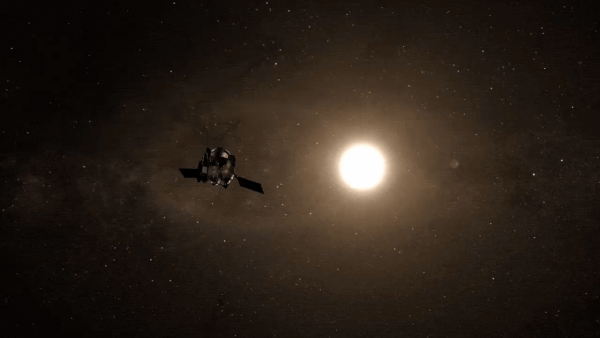NASA's OSIRIS-APEX asteroid probe wakes up after surviving close pass by the sun

OSIRIS-APEX is back online.
Since last December, the NASA space probe had gone on a two-month hiatus as it glided 25 million miles (40.2 million kilometers) closer to the sun than it was designed to operate on its way to encounter a space rock named Apophis.
The OSIRIS-APEX spacecraft inched the closest to the sun on Jan. 2, the first of seven such approaches (or "perihelions") on its calendar before it can reach its target asteroid in 2029. For the past two months, the spacecraft had tucked in one of its two solar panels to protect its most sensitive instruments, an endeavor that limited its power and ability to communicate back home. But NASA has now received enough information from the probe to determine it seems to be performing well.
"Since early December 2023, engineers have had limited information about spacecraft status, as the spacecraft was configured for its safety," NASA said in a statement on Tuesday (Feb. 20). Preliminary data trickling in suggests the spacecraft "performed as predicted," the space agency said in the same statement. But "it will take a few months for the mission team to conduct a full assessment of the spacecraft's performance."
Related: How NASA's OSIRIS-REx mission will help protect Earth against asteroid Bennu and its flyby in 2182
Following the Jan. 2 perihelion, the probe's orbit slowly slid it away from the sun. Early this month, it reached a distance of 60 million miles (96 million km), deemed far enough for the sun to not fry its instruments. The spacecraft then replaced its repositioned solar panel to its original place to once again generate power, said NASA.
An important unknown currently is whether the sun's intense heat damaged part of the probe's surface or components, which may later hinder its performance. Computer simulations done in preparation of this perihelion suggested the readjusted solar panel would keep the probe from overheating, "but any time you take a piece of space flight hardware beyond the design criteria you incur risk," Dani Mendoza DellaGiustina, who is the principal investigator of the mission, had said at the time.
The probe's second of seven perihelions is scheduled for Sept. 1.
RELATED STORIES:
— OSIRIS-APEX prepares for 1st close solar encounter on way to asteroid Apophis
— NASA can't wait for its OSIRIS-APEX spacecraft to meet 'God of Chaos' asteroid Apophis in 2029
The OSIRIS-APEX probe was originally designed to pluck a bit of another intriguing asteroid named Bennu and deliver the samples home. That mission, named OSIRIS-REx, was the first successful U.S. sample return mission from an asteroid. It was crowned a roaring success after it successfully delivered double the amount of material expected, which scientists are still studying for insights into the space rock's formation and evolution.
Since the spacecraft had remaining fuel sufficient for an extended mission after its Bennu encounter, NASA decided to fly it on a one-way journey to Apophis, an asteroid as wide as the Empire State Building thought to be left over from the solar system's birth 4.6 billion years ago.
OSIRIS-APEX is expected to arrive at its target Apophis in April 2029. Although Apophis is classified as a potentially hazardous near-Earth asteroid, NASA has ruled out any threat from the space rock for at least a century.
